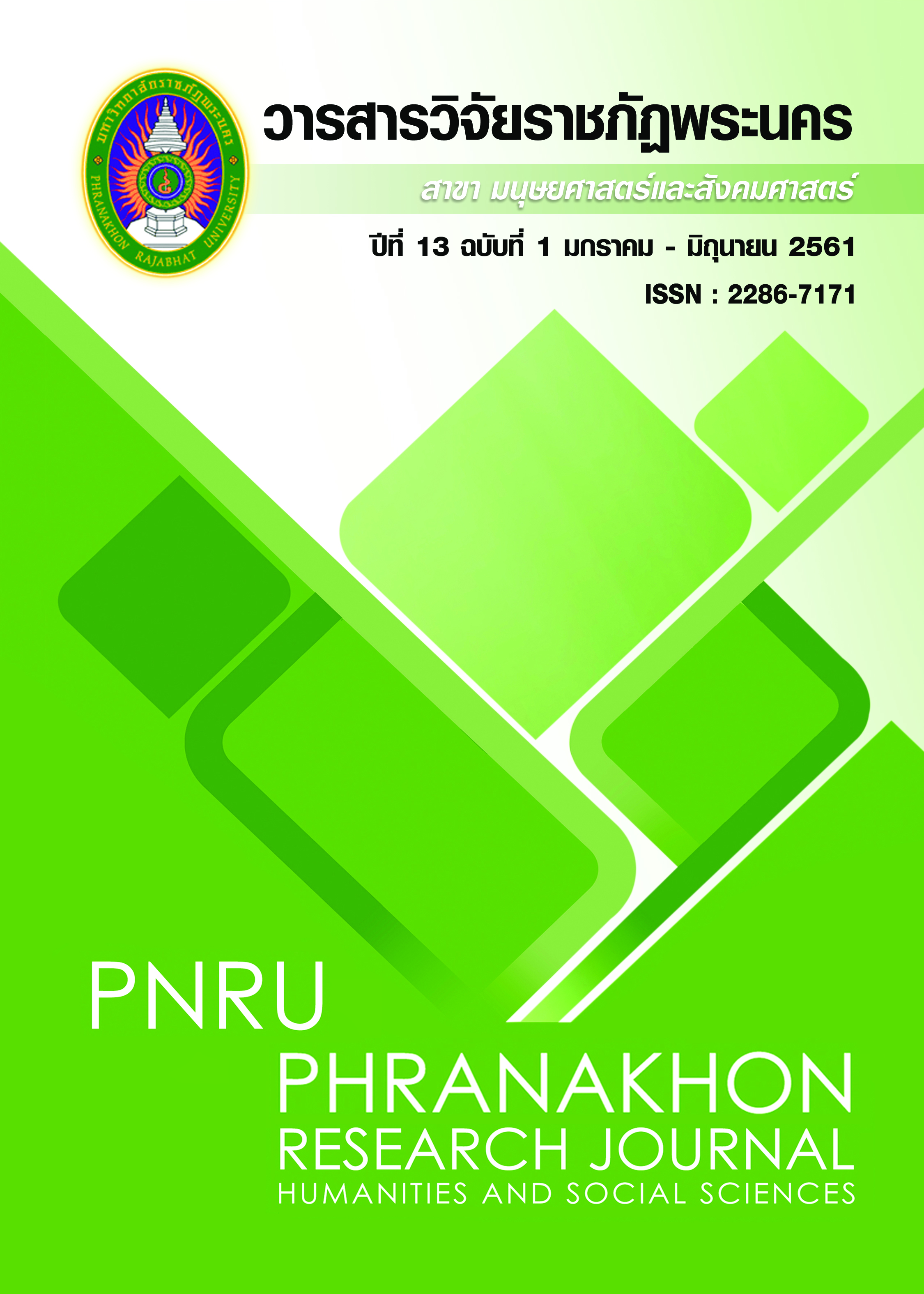THE IMPACT OF EMPLOYEE PERSONALITY TRAITS, PERCEIVED STRESS AND STRESS MANAGEMENT ON QUALITY OF WORK LIFE OF OPERATIONAL EMPLOYEES SELECTED FOR LAYOFF
Main Article Content
Abstract
The objectives of this study were to: 1) study the impact of employee personality traits
on quality of work life of operational employees selected for layoff, 2) study the impact of
perceived stress on quality of work life of operational employees selected for layoff, and
3) study the impact of stress management on quality of work life of operational employees selected for layoff. The tool was the close-ended questionnaire, which was verified by the experts. The reliability test of 0.936 was shown in this study. The statistics used was the descriptive statistics and inferential statistics including the multiple linear regression analysis. The results showed that there was an impact of employee personality traits on quality of work life of operational employees selected for layoff, except the agreeableness and the neuroticism factors. In addition, there was an impact of perceived stress on quality of work life of operational employees selected for layoff. It was also found that there was an impact of stress management on quality of work life of operational employees selected for layoff, except the step of finding strategy and technique to cope with stress, with a statistical significance of 0.05.
Article Details
Each publish articles were copyright by Phranakorn Rajabhat University
Any contents which appeared in each articles in the journal were authors personal opinion. It did not relate to Phranakorn Rajabhat University and other instructors in the university. Each authors would take responsibility on their articles. If there are any mistake, the authors will take responsibility themselves
References
Aldwin, C.M., ed. (1993). Stress, coping and development: an integrative perspective. NY: Guildford.
Bolger, N., & Zuckerman, A. (1995). A framework for studying personality in the stress process. Journal of Personality and Social Psychology, 69, 809-902.
Clark, A. E., Georgellis, Y., & Sanfey, P. (2001). Scarring: the psychological impact of past unemployment. Economica, 68, 221-241.
Cooper, C. L. (1998).Theories of organizational stress. NY: Oxford.
Dewe, P. J., O’Driscoll, M. P., & Cooper, C. (2010). Coping with work stress: a review and critique. Chichester: Wiley-Blackwell.
Easton, S., & Van Laar, D. (2013). User manual for the work-related quality of life (WRQoL) scale. UK: University of Portsmouth.
Ewen, R. B. (2003). An introduction to theories of personality (6th ed.). NY: Lawrence Erlbaum Associates.
Folkman, S., & Lazarus, R. S. (1988). Coping as a mediator of emotion. Journal of Personality and Social Psychology, 54, 466-475.
Freedman, L. (2013). Strategy. NY: Oxford University. Fried, M. R., (2008). Stress management for
success in the workplace. London, Oxford University Press.
Gholami, A. (2009). Factors affecting quality of work life in organizations.
Journal of Human Development and the Police, 6(24), 100-80.
Hicks, T. & Caroline, M. (2007). A guide to managing workplace stress. California: Universal.
Jung, C. (2006). The undiscovered self: the problem of the individual in modern society. New American Library, 23–24.
Lau, R. S. M., & May, B. E. (1998). A win-win paradigm for quality of work life and business performance. Human Resource Development Quarterly, fall 1998, 9(3), 211-226.
Lazarus, R. S. (1966). Psychological stress and the coping process. NY: McGraw Hill
Leandro, P. G., & Castillo, M. D. (2010). Coping with stress and its relationship with personality dimensions, anxiety, and depression. Journal of Procedia Social and Behavioral Sciences, 5,
1562–1573.
Love Bangkok and Promote Bangkok, Statistics, Bangkok. (2014). Retrieved September 1, 2016, from https://www.bangkok.go.th/upload/user/00000130/Logo/statistic/stat2557(thai).pdf (in Thai).
Maltby, J., Day, L., & Macaskill, A. (2009). Personality, individual differences and intelligence. Harlow: Prentice Hall.
McCrae, R.R., & Johns, O.P. (1992). An introduction to the five-factor model and its applications. Journal of Personality, 60(2), 175–215.
McNiel, J. M., Lowman, J. C. & Fleeson, W. (2010). The effect of state extroversion on four types of affect. Journal of Personality, 24(1), 18-35.
Minas, C. (2000). Stress at work: a sociological perspective. The Canadian Review of Sociology and Anthropology, 37(1), 119-120.
Mintzberg, H., & Quinn, J. B. (1996). The strategy process: concepts, contexts, cases. London: Prentice Hall.
Nussbaum, M., & Sen, A. (1993). The quality Description and chapter-preview.
Panpreecha, S. (1996). The manual of selfstress release. Bangkok: Department of Mental Health, Ministry of Public Health (in Thai).
Peneley, J. A., & Tomaka, J. (2002). Associations among the big five, emotional responses, and coping with acute stress. Personality and Individual Differences, 32, 1215-1228.
Pittenger, D. J. (2004). The limitations of extracting typologies from trait measures of personality. Personality and Individual Differences, 37, 779–787.
Poropat, A. E. (2009). A meta-analysis of the five-factor model of personality and academic performance. Psychological Bulletin, 135, 322–338.
Samahingpan, S., & et al. (2012). The developmental care program for psychiatric patients by guardians and community network association. Retrieved September 1, 2016, from
https://www.bro.moph.go.th/html/downloads/STRATEGY/innovation/PDF_Research_5355/05.mentalhealth.pdf (in Thai).
Selye, H. (1976). Stress in health and disease. Reading, MA: Butterworth. Temple, H., & Gillespie, B. (2009). Taking charge of work and life. ABA Journal, 95(2), 31–32.
The Royal Institute. (2005). International religious dictionary: the royal institute edition 2nd edition. Bangkok: Arun (in Thai).
Tichy, N. (1983). Managing strategic change: technical, political, and cultural dynamics. NY: John Wiley & Sons.
Tokhan, K. (2002). Buddhism, society, and Thai culture. Bangkok: Odean (in Thai).
Totton, N. & Jacobs. M. (2001). Character and personality types. Philadelphia, PA: Open University Press.
Visalaporn, S., &k Mulsilpa, W. (1991). The way to solve the stress.Bangkok: Saeangsin (in Thai).
Vollrath, M., & Torgersen, S. (2000). Personality types and coping. Personality and Individual Differences, 29, 367.
Warr, P. B. (1987). Work, unemployment and mental health. Oxford: Clarendon Press.
Winkelmann, L., & Winkelmann, R. (1998), Why are the unemployed so unhappy? Evidence from panel data.Economica, 65, 1-15.
Worrall, L,. & Cooper, C. L. (2006). The quality of working life: a survey of managers’ health-chartered management institute research report. London: CMI.
Yamane, T. (1967). Statistics, an introductory analysis 2nd edition. NY: Harper and Row.


